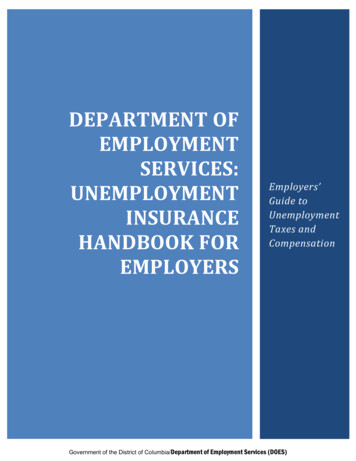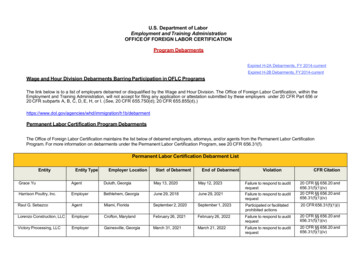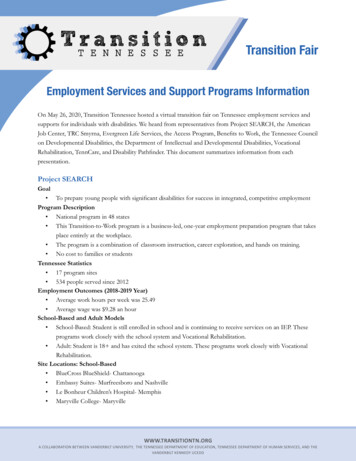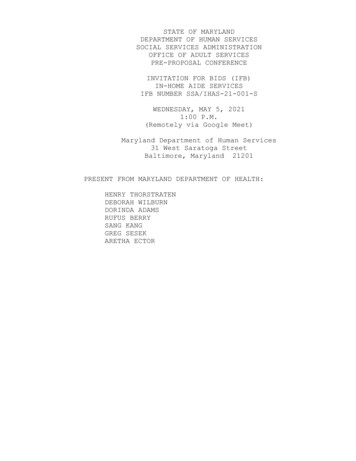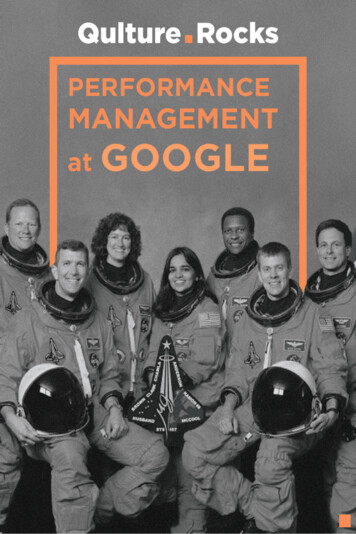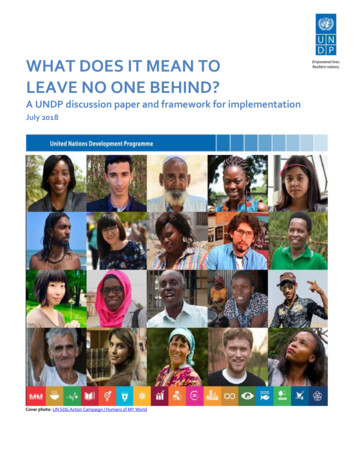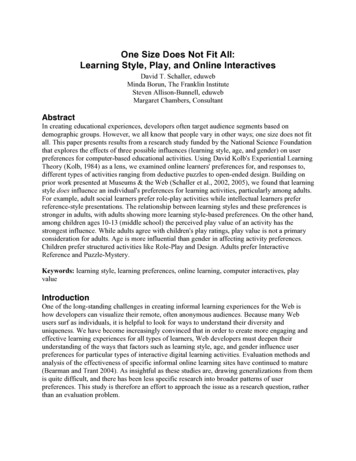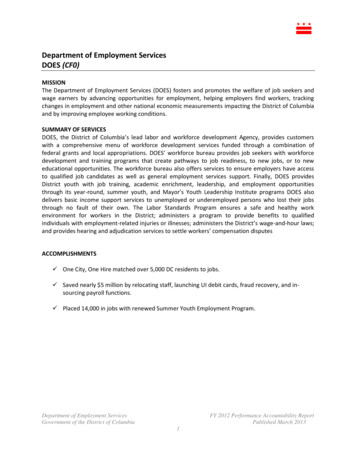
Transcription
Department of Employment ServicesDOES (CF0)MISSIONThe Department of Employment Services (DOES) fosters and promotes the welfare of job seekers andwage earners by advancing opportunities for employment, helping employers find workers, trackingchanges in employment and other national economic measurements impacting the District of Columbiaand by improving employee working conditions.SUMMARY OF SERVICESDOES, the District of Columbia’s lead labor and workforce development Agency, provides customerswith a comprehensive menu of workforce development services funded through a combination offederal grants and local appropriations. DOES’ workforce bureau provides job seekers with workforcedevelopment and training programs that create pathways to job readiness, to new jobs, or to neweducational opportunities. The workforce bureau also offers services to ensure employers have accessto qualified job candidates as well as general employment services support. Finally, DOES providesDistrict youth with job training, academic enrichment, leadership, and employment opportunitiesthrough its year-round, summer youth, and Mayor’s Youth Leadership Institute programs DOES alsodelivers basic income support services to unemployed or underemployed persons who lost their jobsthrough no fault of their own. The Labor Standards Program ensures a safe and healthy workenvironment for workers in the District; administers a program to provide benefits to qualifiedindividuals with employment-related injuries or illnesses; administers the District’s wage-and-hour laws;and provides hearing and adjudication services to settle workers’ compensation disputesACCOMPLISHMENTS One City, One Hire matched over 5,000 DC residents to jobs. Saved nearly 5 million by relocating staff, launching UI debit cards, fraud recovery, and insourcing payroll functions. Placed 14,000 in jobs with renewed Summer Youth Employment Program.Department of Employment ServicesGovernment of the District of ColumbiaFY 2012 Performance Accountability ReportPublished March 20131
OVERALL OF AGENCY PERFORMANCETOTAL MEASURES AND INITIATIVESNumber Fully AchievedMeasures331 2Number Partially Achieved2Number Not AchievedNumber Where Data Not AvailableInitiatives16Number of Workload Measures11Number of Baseline Measures051015202530RATED MEASURES AND INITIATIVESRated MeasuresRated InitiativesFully AchievedPartially AchievedFully AchievedPartially AchievedNot AchievedData Not AvailableNot AchievedData Not Available22%11%41%33%34%59%Note: Workload and Baseline Measurements are not includedDepartment of Employment ServicesGovernment of the District of ColumbiaFY 2012 Performance Accountability ReportPublished March 20132
Performance Initiatives – Assessment DetailsPerformance Assessment Key:Fully achievedPartially achievedNot achievedData not reportedAgency ManagementOBJECTIVE 1: Improve Office of the Director Management and AdministrationINITIATIVE 1.1: Agency-Wide Digitization.Partially Achieved. DOES has continued to make progress in migrating the collectionand management of information in electronic formats that was prior collected in paperform. In addition DOES has created in house software tools that enable UI documents tobe digitized and placed in a repository that is accessible and affiliated with related claims or employers. Although these initiatives have greatly reduced the amount of paperbased information that the Agency must manage, we are still actively pursuing a singleapplication solution that can be leveraged throughout all DOES business processes toboth manage document storage and document workflow. Once deployed thisapplication will replace the mitigating solutions we currently have in place.INITIATIVE 1.2: Upgrade, Augment, and Modernize the Agency’s Web Presence.Fully Achieved. The new DOES website was launched in early August 2012. This effortconverted the site from our antiquated DSF web platform to our new, easier to useDrupal web platform, updates all content, and now displays a contemporary look andfeel that visitors should experience when coming to a District government website. The site also provides a more citizen centric design with enhanced navigation and usability,which now makes it easier for visitors to access the programs and services that DOES hasto offer and allows us to better connect with the public. The new site reflects the work ofmultiple OCTO teams and DOES staff setting up the infrastructure, developing the newweb templates, and assisting in the migration and transition to the new site.INITIATIVE 1.3: DOES Support of System of Accounting and Reporting (SOAR)Replacement Initiative.Partially Achieved. In FY12, the OCFO worked with OCTO to create unique combinationcodes in PeopleSoft that would allow for proper time and labor distribution directly inPeopleSoft; which in turn eliminated the need for manual entry into the DOL FARS. This effort was undertaken to improve the accuracy and timeliness of programmatic andfinancial reporting. OCFO lead several trainings of DOES staff in early FY13 to ensure allemployees are familiar with the new way of reporting time in PeopleSoft through theuse of combination codes; in order to ensure that time is properly allocated to the grantprograms by DOL function where required. Since the implementation of EnterpriseBusiness Solution (EBS), “SOAR Replacement” is citywide, DOES’ finance team continuesDepartment of Employment ServicesGovernment of the District of ColumbiaFY 2012 Performance Accountability ReportPublished March 20133
to work with the OCFO to implement the necessary components required for DOES intoEBS.INITIATIVE 1.4: Deploy a Unified Agency Change and Incident Management System.Partially Achieved. Office of Information Technology (OIT) is in the process of procuringan asset management software package that will allow and support the capability toremotely manage and administer Agency desktop resources. The Numara Footprintsapplication that is being purchased will serve as an enterprise change management toolthat will be leveraged to support various Agency program areas, including Office ofInformation Technology, Office of Administrative Services, Human Resources, and otherprogram areas as needed. The purchase and installation of the software will becompleted by December 2011 with full scale implementation completed by April 2012.The Numara Footprints applications will provide critical change management capabilities and also provide desktop management functions including asset discovery and tracking;operating system and applications software deployment; software patch management;and remote management. This application will also serve as a centralized IncidentReporting, Tracking, and Management tool. The result of this initiative will bestandardized change management and incident management capabilities which willallow management to have a single desktop view of the status of all change and incidentrequests. This will create an environment where incidents will be managed quickly andefficiently, with a minimum of waste and duplicated effort, creating substantial costssavings for the Agency while simultaneously improving business processes.INITIATIVE 1.5: Deployment of a Centralized Solution for Desktop Maintenance, AssetManagement and System Upgrades.Partially Achieved. OIT will utilize the Numara Footprints software purchased as part ofInitiative 1.4, above, to perform remote desktop management maintenance, automatedasset management, inventory, and upgrade functions which will enable IT staff tomonitor, update, and maintain a standardized software environment for all Agencycomputers. The deployment of this centralized solution will be completed in February2012. This project will significantly decrease the level of effort and amount of time that it takes IT to perform routine patch maintenance and software upgrade tasks, reducingcosts while increasing staff productivity. Additionally this technological toolset willprovide IT technicians the ability to monitor and review installed software applicationson Agency computers to ensure compliance with Agency software baseline standardsand industry best practices. The software and associated workflows will be implementedin phases 2012.INITIATIVE 1.6: INITIATIVE 1.6: Improved Facilities Management and Sustainability of the Fleet Vehicles.Fully Achieved. In FY12, DOES successfully relocated approximately one-hundred (100)employees from the Labor Standards Bureau to the DOES HQ in NE DC. The agency savedDepartment of Employment ServicesGovernment of the District of ColumbiaFY 2012 Performance Accountability ReportPublished March 20134
1.7 million in lease costs. The consolidation of the Agency to the new headquarters hasallowed DOES to centralize the location and management of its vehicle fleet. Thispractice has enabled DOES to reduce and better manage/resolve ticket activity resultingin 90% of the total fleet being ticket free which better positions the agency to qualify toexchange existing vehicles for more compact fuel efficient cars as they become availablethrough DPW. Additionally, usage data shows that continuing efforts to encourage fleetshare participation coupled with METRO and Bike Share accessibility to the new buildingpresents an opportunity for DOES to further reduce their vehicle fleet by two or threecars. Additionally, DOES has developed and implemented standardized policy andprocedures for the Fleet program. This policy defines responsibilities of operators,managers, as well as that of the Office of Administrative Services which has oversight forthe program. It further clarifies the difference between the DOES Fleet Program and theDistrict’s Fleet Share program in which DOES employees are enrolled and outlinesprocedures for DOES employees to participate in both programs.Labor Standards Program (LSP)OBJECTIVE 1: Provide a more efficient and effective system to prevent workers fromexposure to unsafe working environments and from falling beneath an unacceptableincome level at times of unemployment due to injury/illness.INITIATIVE 1.1: Upgrade the Office of Workers’ Compensation’s (OWC) CORE/ICISautomated document case management system.Partially Achieved. The legacy nature of the OWC's CORE/ICIS system presents uniquechallenges to the maintenance and modernization of these systems. DOES is workingclosely with the original system vendor to move the architecture onto a stable, robust platform. Given the scale and scope of this system the planning required has beenextensive, but that work is now complete and DOES is entering the ImplementationsPhase. DOES projects completion of this project on the previously communicatedschedule (end of FY 2013). Once complete, OWC's system will be much more flexible andmore amendable to integration into DOES' overall modernization strategy.INITIATIVE 1.2: Stabilize, Upgrade & Modernize the Agency’s Legacy Worker’sCompensation System.Partially Achieved. Along with the stabilization and system improvements referenced in1.1 above, DOES is working towards a unified approach to document imaging andworkflow management. A single system, leveraged across the Agency's various businessunits, will enable DOES to benefit from increased efficiencies while reducing system maintenance and overhead. OWC is planned to be a pilot department in thisimplementation, utilizing their acquired experience and expertise across these types ofbusiness processes. Document Imaging and Workflow Management is an essentialcomponent of DOES' overall modernization strategy and building a reliable andconfigurable management engine will be a key factor in the successor that initiative.Executing this strategy will be a major initiative in DOES OIT throughout FY2013.Department of Employment ServicesGovernment of the District of ColumbiaFY 2012 Performance Accountability ReportPublished March 20135
INITIATIVE 1.3: Decrease significant workplace injuries and illness through directintervention to reduce workers exposure to unsafe working environments.Fully Achieved. During FY 2012, OSH conducted a total of 373 visits of all kinds. Of these,268 were in area of emphasis (high hazard establishments, i.e. residential construction, etc.), and includes initial, training and follow- up visits. This number exceededexpectation. Addition accomplishments resulting from OSH visits conducted: 743serious hazards were identified 6,740 employees were removed from risk Safetytraining was provided on-site for 496 employees 99% of visits were for smalleremployers.Office of Policy, Performance & EconomicsOBJECTIVE 1: Increase the identification and implementation of best practice policies andcontinuous improvement, standard operating procedures, and utilization of tools withwhich to assess the future and economic state of jobs and job statutes; assess the viabilityof available jobs, unemployment, and wages to ensure the accuracy and efficiency of datacollected across departments, offices, and programs.INITIATIVE 1.1: Develop credible and appropriate measures of performance(Performance)Partially Achieved. OPPE conducted a comprehensive assessment of all WIA programs toaddress issues identified by the U.S. Department of Labor (DOL) to develop a swiftcourse of action to respond to our customers and federal partners. In order toaccomplish a thorough assessment, OPPE established Focus Groups that includedmanagers, frontline staff, and support staff to identify several underlying causes forunderperformance and late, error-ridden reports. Consequently, the Workgroupsconducted analysis that identified impediments to programs meeting performance goals.As a result of this engaged leadership, and effective communication of the organizationalvision, mission, goals, and requirements, the agency has consistently met performancegoals and adhered to reporting requirements, including overall improvement incustomer service and increased confidence among employers and key stakeholders, resulting in more efficient and timely responses to our clients, especially ourdisadvantaged population. The new technologies improved operational efficiency andincreased capacity, enabling staff to achieve efficiencies and enhance services to clients.DOES concluded Program Year (PY) 2011 by meeting or exceeding all three negotiatedlevels of workforce performance for WIA Adults as required by DOL , achieving anentered employment rate of nearly 60 percent, an employment retention rate of 77.6percent, and an average earnings rate of 13,013. The employment retention andearnings outcomes both exceeded negotiated levels of performance by 17.6 percentagepoints and 1,263, respectively. The Agency met or exceeded the negotiatedperformance standards for the dislocated worker program, achieving an enteredemployment rate of 67.2 percent, an employment retention rate of 85 percent, andaverage earnings of 21,064. The employment retention and earnings outcomesexceeded negotiated levels by 16.8 percentage points and 6,064, respectively.Department of Employment ServicesGovernment of the District of ColumbiaFY 2012 Performance Accountability ReportPublished March 20136
INITIATIVE 1.2: DOES conducts targeted reviews of workforce programs operationprocedures to improve services and ensure that information and services provided tocustomers are in accordance with federal requirements.Partially Achieved. Beginning in the First Quarter of FY12, OPPE in collaboration withprogram managers throughout DOES established working groups to review currentprogrammatic procedures. The goal was to develop and archive Standard OperatingProcedures (SOP)s and policies and make them easily and widely available to all DOESemployees and to the public, as appropriate. The result of the working group was thedevelopment of SOPs for the following program areas: American Job Center operations; Business Solutions Group; Unemployment Insurance; Youth Services; Apprenticeship;Workforce Investment Act (WIA) Adults and Dislocated Workers; Special Programs, andthe Transitional Employment Program. The first installment SOPs was completed onNovember 1, 2011. The majority of SOPs were completed in draft form on April 6, 2012,and the final installment of the draft SOPs were completed on June 6, 2012. All SOPs arecurrently undergoing an intensive review and approval process. These SOPs will supportemployee productivity and improve their work product, promote transparency, andallow for a centralized, archiving process to ensure predictable end results, even ifemployees depart or leadership changes.INITIATIVE 1.3: provide quality economic and workforce information and analysis toguide the District’s policy makers and benefits the Agency’s customers. (Economics)Fully Achieved. The work of the Office of Labor Market Research and Information(OLMRI) is governed by two documents: the LMI Cooperative Agreement with theBureau of Labor Statistics (BLS) and the Workforce Information Grant (WIG) provided bythe US Department of Labor. OLMRI complied with the BLS LMI Cooperative Agreementand met all major deliverables in a timely and accurate manner. To comply with therequirements of the WIG, OLMRI met the following deliverables: continued to populateits DC Analyzer Internet System (which serves as the Workforce Information Database)with state and local data; produced and disseminated 10-year industry and occupationalemployment projections for DC and the Washington MSA as well as 2-year projections for DC; conducted and published relevant economic analyses, special workforceinformation, and/or economic studies (including the 2011 Annual Economic Report forDC) of benefit to the Mayor and the Workforce Investment Council (WIC); postedproducts, information and reports on the internet; and collaborated and consulted on acontinuing basis with the WIC and other key workforce and economic developmentpartners and stakeholders to improve LMI-WI products, tools, and information servicesto meet evolving customer needs. In FY12, the DC Analyzer website had 6,652 visits,77,874 page views, and 212,788 hits. OLMRI responded to weekly LMI requests from theWIC, the Executive Office of the Mayor, DMPED, OSSE, DCPS, MPTD, and other divisionswithin DOES. OLMRI consults and communicates with these customers to betterunderstand their data needs and tailor the provided information and analysisaccordingly. OLMRI awarded a grant that will survey and interview employers andtraining providers to map out employer hiring preferences and the skills gap in DC. TheDepartment of Employment ServicesGovernment of the District of ColumbiaFY 2012 Performance Accountability ReportPublished March 20137
grantee will use economic modeling to determine the multiplier effect and economicimpact of growth in DC’s top industries.Unemployment (UI) ProgramOBJECTIVE 1: Increase the efficiency and integrity of unemployment compensation benefitsand unemployment tax services provided to unemployment insurance claimants andDistrict employers through the creation and leveraging of technological solutions.INITIATIVE 1.1: Debit Card Solution for UI Benefits Payments.Fully Achieved. The Department of Employment Services launched its debit cardprogram in December 2011. The debit card is now the primary method of payment for UIpayments, eliminating the expense and significant amount of manpower used to process and distribute paper check payments. Payment of benefits by debit card also helps toensure that claimants receive benefits in a timely manner and eliminates check fraud.The project resulted in a 1,041,764 savings in FY12, as calculated by the Office ofFinance and Treasury.INITIATIVE 1.2: Implementation of the IRS Treasury Offset Program to aid in therecovery of Benefits Overpayments.Fully Achieved. The Department of Employment Services initiated the TOP program as apart of the greater federal imperative to increase the prevention, detection, andcollection of Unemployment Insurance (UI) ov
The Numara Footprints applications will provide critical change management capabilities and also provide desktop management functions including asset discovery and tracking; operating system and applications software deployment; software patch management; and remote management. This application will also serve as a centralized Incident

